#found in Portugal and Spain mostly
Text
Spanish Iris / Lirio español

#spanish iris#lirio español#don't mind me#just knew about this flower yesterday#it's so beautiful#though it is usually a paler violet like colour#found in Portugal and Spain mostly#but also Corsica South Western France Southern Italy Algeria and Tunisia
5 notes
·
View notes
Text
@unhonestlymirror i need to go to sleep
This was halfly popularize
Let's start off with Angyalistan and Užupis, since I don't have anything to add to what you already know about them x)
+only thing I added is the infinity symbol under Angyalistan's bc I felt like it+had to find a way to nod to the concept of horizon/infinity
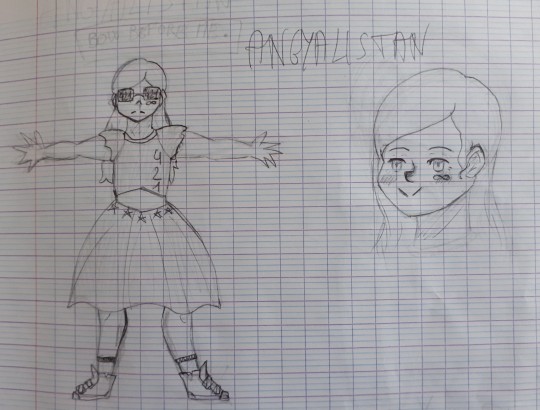

Next are Mùnegu (Monaco in Eng, Italian, and everyday life French, Monègue in older French, Mónegue in Occitan) and Andorra (Andorre in French):
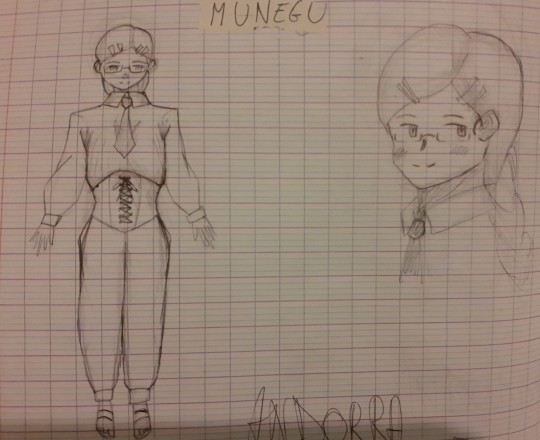
Mùnegu:
while she indeed depends on France for military defense, she's very much capable and doesn't rely on him for everything! (dammit!) - she's quite rich (altho the fact she doesn't have many citizens must help)
seem to have a relationship with the Holy German Empire, Spain Kingdom and Italian kingdoms but it made my head hurt with how much dates there are) - gained independence from Genoa in 1247, independence from Holy German Empire in 1524 and becomes a protectorate of the Spanish Kingdom until 1641 where Mùnegu becomes a protectorate of the French Kingdom, then becomes a protectorate of the Sardinia Kingdom from 1815 to 1860. In 1918, becomes a sort of protectorate of France anew
During WW2 scared to be invaded by Italians, went to ask (then Vichy) France what to do to which France replied 'just let them'. So Mùnegu was occupied by Italians in 1942 and then by German in 1943. Helped to deport Jews
christian, catholic (freedom of religion for the people, but the State is still catholic)
abortion became legal (2019) but it's still a mess so the women are encouraged to go to France, Italy or another country where it's legal and less of a mess
Speaks Monegascan/Monegasque, French, then Italian (and English for business ofc)
tried to draw her more 'classy' and organized (?) I still haven't understood the purpose of the hairstyle she canonically has

Andorra:
Actually much more closer to Spain (and Portugal), part of the Iberian Peninsula
For an old reason, both French's government representative (nowadays, the President) and the bishop of Urgell in Catalonia in Spain are ruling over Andorra as co-prince (since 1607)
Has been around since at least the X-XI century
got annexed by the French Empire from 1812 to 1814
His territory has remained unchanged since 1278
Speaks Catalan, then Spanish and Portuguese and then French (but less)
He wasn't invited to the Versailles Treaty so he was officially at war with Germany between 1914 and 1958
during both World Wars and their aftermaths was used as a way to cross the French-Spain border by lots of different people for different reasons (deserters, nazis, Jews, Spanish people fleeing Spain...)
Abortions are illegal (so you have to go to France or Spain to have them)
christian catholic
legend says that Charlemagne gave Andorra a charter
(+Andorra is in the middle of nowhere in the Pyrenees)
is to France and Spain what Liechtenstein is to Switzerland - but they care less about him than Switzerland can care about Liechtenstein

Aigues-Mortes:
It's kinda hard to talk about Aigues-Mortes because the micronation was created in 2011 but the city has been around for several centuries
'Aigues-Mortes' literally means 'Dead Waters' (reference to the fact there are several ponds and swamps in Aigues-Mortes and around the city. The bodies of water stay still)
In 1248, Louis IX named the city 'Bona per Forsa' ('Good despite fate'?) after the inhabitants' request but the name Aquae Mortuae, later Aigues-Mortes will stay
After the Revolution in 1789, the city changed its name to 'Port Pellier' but once again, the name didn't stick around
August 1893: 'Italian slaughter.' (7 deaths, 50 injured, not a single culprit will be sentenced). Biggest slaughter of immigrants in French contemporary history
More about the micronation now!: motto can be translated as 'Love thy neighbor and steal/drink their wine!' - says her religion to be 'Catalcoolisme' ('Catalcoholism'; play of word between 'Catholicism' and 'alcoholism' I suppose); worship rosé (type of wine)
Was created when two friends got drunk (drinking rosé, ofc)
Looks up to Monaco; wants to become like Monaco (hence why she tries to dress up with the same type of clothes Monaco dresses with (classy) and why I made her dyed her brown hair in blonde)
has the French south accent!
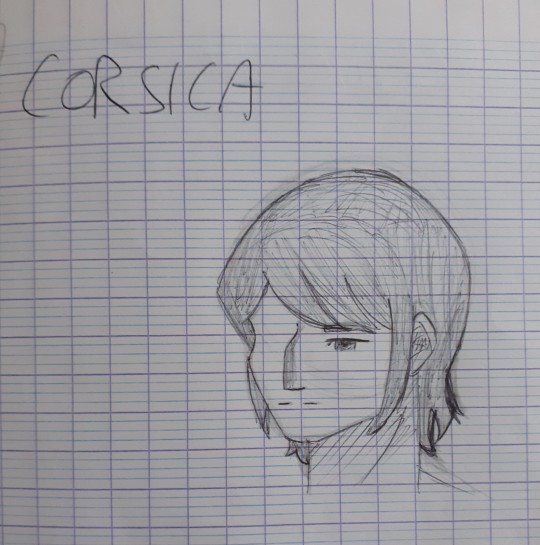
Corsica:
was ruled by Genoa from 1284 to 1755 (fought for independence from 1729 to 1755). Became a Republic until France annexed Corsica in 1769
several historical ties with (what is nowadays) Italy
Got a bad reputation bc of FNLC (National Liberation Front of Corsica) mostly. From 1974 to 2014, the nationalist group bombed (public buildings, banks..), made several armed robberies, as well as aggravated assaults and murders/assassinations against French symbol and government and advocated for independence + presence of organized crime
renowned for her beauty
bonds with Breizh over France+luxury tourism destroying their lands and their languages dying out
otherwise doesn't have any ill intention toward continental French people (if you're respectful with her, she'll be respectful with you)
is known to have a strong sense of community/family
isn't going to scream at every opportunity she gets that Napoleon (Napoleone Buonaparte) was Corsican but she's never going to forget it+little pride
wants more independence from France but numbers show that Corsican people do not wish for full independence
occupied by Italy and Germany during WW2; first French territory to be freed
mainly catholic

Frioul:
Already talked about him!
he's the one where you have to have a permit to wear flip-flop lol
Drink respect women juice everyday
insolent but never insulting
doesn't like the heat (he is a bit tan because he is in the south of France but tries his best to stay in places where there's no sun) (most than likely carries a mini-ventilator around and stays indoors+carries a sunshade/parasol outside)
Prankster with calm energy
hates unnecessary commotion/noise (also hates the necessary one but understand it)
has the French south accent!
Was Naple's at first (until the XIVth century where he went from Frenchman's control to Frenchman's control; until he eventually became part of France)
Micronation since 2011

Saugeais:
Created in 1947 as a joke by a prefect and a hotelier (in a abbey?)
at the border with Switzerland
anthem is written in old patois/dialect which France can barely understand
it seems like the dialect has been dying since the last century so I don't know if he can still speak it? Probably has an accent
organizes a sport competition every year (mountain biking, kayaking, running..)
Dracystan and Anthophilia are next! They were both created in 2020 so I made them quite young+They were the only newly micronation that had enough personality for me to work with them - which means France has about 20+ children (but they're 1 or 2 dimensional? kinda ghosts? how would they (not having a defined identity) be portrayed in hetalia/how can they be personified)
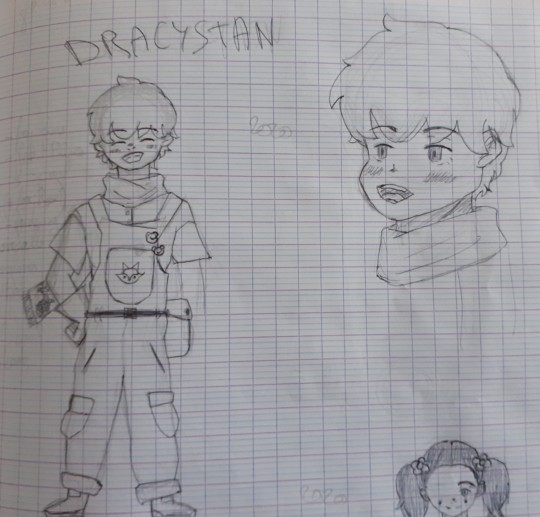
Dracystan:
does a lot of clean-ups and gardening; carries gardening and clean-up tools around
any person loitering will be sanctioned/sentenced to remove stinging nettles with their bare hands. it's the law
loves fairy tails! It is said that Once upon a time, the king of Dracystan turned into a frog
gave him frog pins (+ didn't draw it here but he has a frog hat, you know the ones!)
being honest, i thought about The Little Prince while drawing him so that's why he got a scarf and a fox on his overall-
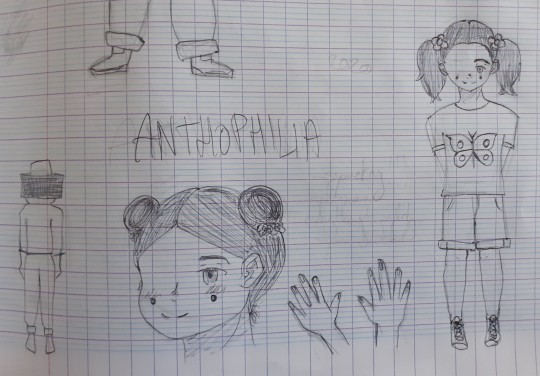
Anthophilia:
SYMMETRY. insects love symmetry, Anthophilia loves insects, so she wears symmetrical clothes and keeps her hair symmetrical too + you can't see it since I didn't color but she's wearing nails polish (orange-red-black-red-orange on each hand))
particularity cares about bees, but also butterflies, bumblebees, birds, nectarivore mammals...
#anthophilia dracystan and frioul are france's children#we can count Saugeais as one too#not sure what Aigues-Mortes may be. a sister perhaps?#Andorra is part of spain and portugal history mostly but france does take care of him a bit (even tho he forgets about him often and doesnt#care much - but its the same for Spain or so i heard)#no change for Monaco/Mùnegu - history with france seems relatively stable#Corsica.. I.. corsica and france sure have a difficult relationship (france's fault) - she's not his sister and definitively not his#daughter but they do share history and from what i found Corsicans are neutral about french people (like 'yeah they exist') (extremist ppl#aside)#even if Corsica might or might be not considered France family (because i dont know any corsican person to get an irl opinion) i hope i mad#a design for her that would be accepted by corsican ppl should they ever see it#corsica+breizh+some/several islands should go into 'officially france family despite if they want or not' or 'forcefully adopted against#their will' (most (not all tho. surprisingly.) of the annexation/colonization were violent. unsurprisingly.)#I will give you the flag of some of them ^ in another post tomorrow#or something
3 notes
·
View notes
Text
it’s time for the JOblr census results 🧡🙌
before we start i want to thank everyone who took their time to answer this silly little project, gathering responses from 203 baby boos!! it’s my first time doing this so hopefully i can bring some excitement with the results <3
so buckle up and let’s get into it
general questions
Which continent are you from?

Unsurprisingly, the majority is European with a total of 80.8% but it’s amazing to see that they’ve crossed the continent’s border and we also have 9.9% people from North America, 3.9% from Australia & Oceania, 3.4% from Asia and 2% from South America. No person chose the Africa option.
Which country are you from? (optional)
With this being an optional question, 162 respondents out of 203 opted to answer it. Let’s take a look at the top countries by number of people in JOblr (small note: I counted the few people who wrote England or Scotland as part of the UK answer)
Drumrolls ���…..
Finland - 29
UK & USA - 15
Germany - 11
Poland - 9
Italy - 8
Australia - 7
Sweden - 6
Austria, Spain, The Netherlands - 5
Croatia, Slovenia - 4
Czechia, France, Romania - 3
Belgium, Canada, Denmark, Hungary, Lithuania, Norway, Philippines, Portugal, Ukraine - 2
Bolivia, Brazil, China, Estonia, Greece, Iceland, India, Luxembourg, Malta, Mexico, Russia, Switzerland - 1
How old are you?

45.8% of us are between 18-25, following by 23.6% between 26-30, 18.2% between 31-45, 10.8% under 18 and two people who are over 45 years old.
Are you part of the LGBTQ+ community?
Remember when they said Joker Out are for the girls and gays? 🏳️🌈
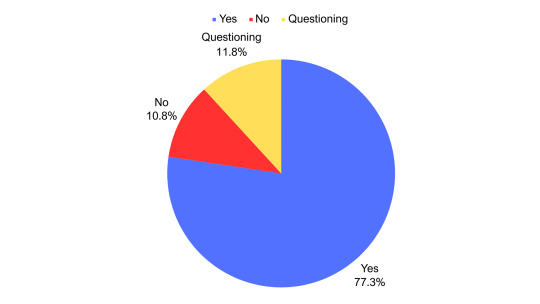
Well that was absolutely not wrong since 77.3% baby boos answered that yes they are part of the community, while 11.8% are questioning and 10.8% have answered no
tumblr activity questions
How do you participate on JOblr?
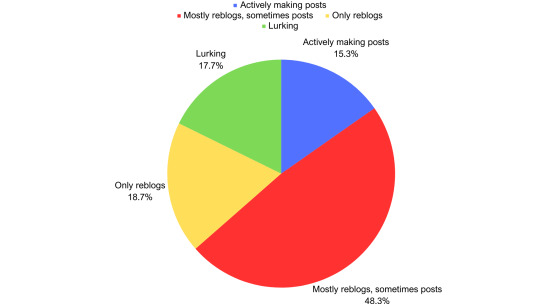
a majority of 98 people are mostly reblogging posts in the fandom but sometimes making posts of their own, 38 are only reblogging while 36 lurkers have stepped out of the shadow and made themselves known. The least amount of people (31) said to be active posters
Do you post any of the following?

It’s already known this fandom is mad talented and entertaining!! It’s always a joy seeing everyone’s creations and posts no matter the type. And the people who are only enjoying and supporting the content are just as important 🫶
Do you also post about Käärijä?
Since these two fandoms are basically overlapping, sometimes even seen as one fandom, I was curious just how much

50.7% also post about Käärijä outside of Joker Out, while 35% don’t post about him at all (or perhaps very rarely). 14.3% are mainly coming from Käärijä’s fandom
joker out questions
How did you find out about Joker Out?
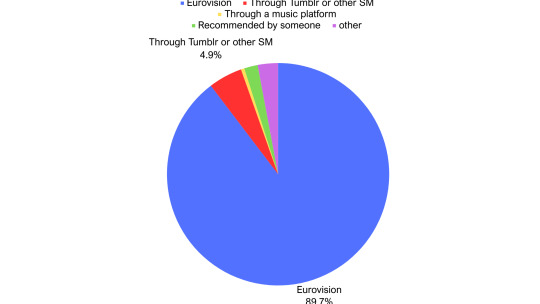
Another unsurprising result, with 89.7% of us finding out about them through Eurovision. But it was really cool to see that there are people who discovered them differently. Ten people found out about them through Tumblr or other social media, to four they were recommended by someone and one through a music platform. The “other” option was chosen as well and included:
finding out about JO through Käärijä
through a music blog review
on slovenian radio
Who from the current members is your favorite?
One of the hardest questions but it had to be done
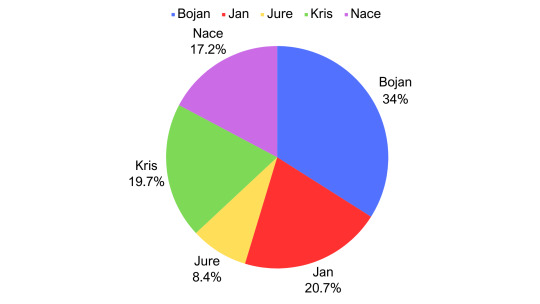
So Tumblr’s top favorite members areee:
Bojan - 69 votes
Jan - 42 votes
Kris - 40 votes
Nace - 35 votes
Jure - 17 votes
Have you been to a Joker Out concert?

I did not expect this one to be so balanced but I am pleasantly surprised! 104 people have been to a JO concert, while 99 haven’t. It often feels like you’re the only person who hasn’t seen them live yet but it’s nice to see that you’re not alone, so if anyone feels the same don’t worry our time will come too 🥹
If you answered yes, have you seen them multiple times?
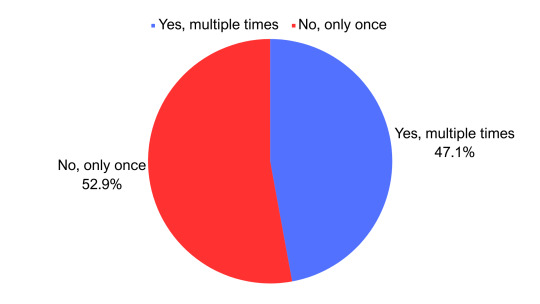
Out of the 104 people who previously answered yes, there’s still a balance between those who have been to only one concert and those who have been to multiple
If you’re into RPF, which one of the most popular ships (according to AO3) is your favorite?
Another optional question where 181 out of 203 opted to respond to.
Oh boy, ooooh boy this was a tough battle. It felt like I was watching a horse race. I can tell you that all three ships have been at some point in the first place, or even equal. Are you ready to see the most interesting result yet?
Drumrolls again 🥁…….
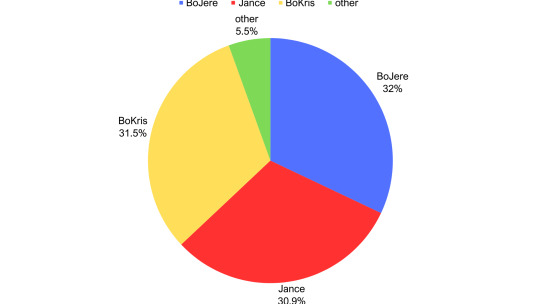
BoJere - 58 votes
BoKris - 57 votes
Jance - 56 votes
The “other” option was also chosen and the following ships were included:
BoMartin
Jan/Jure
Kris/Jure
Nace/Kris
Nace/Jere
poly!JO
aaaand that’s it, you made it to the end 🫶 hope you enjoyed and why not see you on the next census!!
#sorry in advance for any grammar mistakes:))#joker out#bojan cvjetićanin#jan peteh#jure maček#kris guštin#nace jordan
139 notes
·
View notes
Text
In Latin America there’s this weird popular culture thing going on with an old 70’s Mexican show called El Chavo del 8 (the kid from the 8)

It’s a sitcom based around a vecindad (a type of multifamily apartments) with a small rooster of characters, both kids and adults, all played by adult actors, with 2 or more characters played by the same actor, with the simple premise of the trials and tribulations of living in said vecindad, and how each character clashes with each other.
Well, this is still massively popular all over Latin America, even in Brazil, where the dubbed version, called Chavez, is as equally popular as in spanish-speaking countries, and it’s all thanks to constant reruns and a sort of simple yet timeless comedy routine based around physical violence, akin to the looney tunes, to the point you can find someone like my 92 year old dad laughing his ass off at an episode next to his equally laughing 8 year old great grandson.
It’s so popular, it even found ground in Spain, a country notorious for not enjoying Latin American-based media, with even some fans found in Portugal thanks to the Brazilian dub.
So, this is all well and good, so what’s the weird part you must be asking? If it’s good, which it is, surely it’s a good enough reason for its popularity.
Well, here’s the thing, in Mexico, the country where the show was made and almost all their cast is from, well, they just don’t care about it, nor seem to really understand why the show is so massively popular outside their country.

Look, El Chavo was so massive, at one time its actors all founded circuses and toured around Latin America for years, finding great success whenever they went, and even with all the years that have passed, and with half the original cast now passed away, people all over this region still recognize the actors, and they still get interviews and random television spots to this day, but again, mostly OUTSIDE Mexico.
Hell, when the actor of the main character of the show, Roberto “Chespirito” Gomez Bolaños, who played the titular El Chavo, passed away some years ago, it became massive news in Latin America, with TV specials made and even government officials speaking out about his passing.
And yet, Mexico still refuses to give a shit about it, and man, I find that so bizarrely weird.
52 notes
·
View notes
Text
Vampires before they were cool... (2)
In my last post, I left you by the 16th century. But it was the 17th century which was the BIG century for the evolution of the vampire myth.

During the Middle-Ages, the vampire manifestations were mostly localized in Western Europe: vampire tales came from the British Isles, from France, from Spain, from Portugal. However, throughout the 16th century, these phenomenon rarefied themselves in the West… Only to brutally amplify and multiply by the East. In the 17th century, vampires popped up everywhere in the Balkans, in Greece, in Russia, in the eastern part of the Austro-Hungarian empire. In fact, by the 17th century, vampires had turned so rare in Western Europe that some people (like Voltaire in France) would later believe vampires were “invented” by the 17th century and did not exist prior to this date…
Why such a big shift? Well, sociologically speaking, Eastern Europe was a poor and isolated part of Europe at the time. The great innovations and inventions of the Renaissance had not crossed over to the East, unlike things like the vampire tales, which travelled very fast – and while the bourgeoisie and the city-dwellers of Eastern countries were educated, the rest of the population, the peasants and the folks of the countryside, usually did not know how to read or write. It was a fertile ground for folktales to take root and superstitions to manifest themselves… But there was a second reason that amplified this one: a religious difference. In Western Europe, it was a time of hunts and persecutions of all kinds – be it the Catholic Church and its Inquisition who led a merciless fight against anything deemed an “heresy” or a superstition contradicting its canon beliefs; or the Anglican Church of the Stuarts who caused one of the largest witch hunts of history. These phenomenon caused the disappearance and erasure of the vampire myth in Western Europe… But to the East, the Byzantine-descending Church had a more open-mind and a greater tolerance when it came to local folk-beliefs, even including superstitions in its rites and practices: as such, the vampire myth was welcomed by the religious authorities – a case being the brucolacs of Greece.

The Greeks have very ancient beliefs when it comes to the dead who do not rot and get out of their graves: the archetypal case is the one of the “vrykolakas” (usually re-written as “brucolac”). They were people turned undead because they were not buried in a holy ground (death by suicide, or being excommunicated). However when the legend of the vrykolakas started they were… harmless and pitiful creatures. They were tormented souls who only sought to escape the physical body they were trapped within, and did not harm humans: to send them to an eternal rest, the Church just had to remove its excommunication and their soul would be at peace. However, from the 16th century onward, the nature of the vrykolakas changed with the arrival from the West of these yet-unnamed harmful undeads. And this lead to a confusion with werewolves.
Yes, werewolves: “vrykolakas” was also a Greek term to designate werewolves, who were very present in the folklores of the Balkans or the Carpathians. The werewolf myth was, just like the vampire myth, crystallized by the Christian medieval beliefs. And just like the vampire, it had an “official” recognition: Sigismund, king of Hungary and leader of the Holy Roman Empire (1368-1437) had the Ecumenical Council of 1414 recognize officially the existence of werewolves, and in the 16th century the Roman Church led official investigations on lycanthropy. Between 1520 and the mid-17th century, more than 30 000 cases of lycanthropy had been reported in Europe (in the West, France was the most touched, while in the East they were found mainly in Serbia, Bohemia and Hungary). A rumor started spreading around, about how when werewolves died they turned into “blood-sucking undead”. This led, in the end of the 17th century, to the apparition in popular culture of vampire-werewolves entity. They were found in Silesia, Bohemia, Poland, Hungary, Moldavia, Russia, and of course Greece, where the peaceful brucolacs were turned into bloodthirsty monsters ; and by the 18th century they covered pretty much all of Northern and Central Europe. Every country had its own terms, its own names, and its own traditions when it came to these undead: “upir”, “brucolac”, “blutsauger”, “vulkodlak”… In Slovakia and Romania for example, the “dead that walks” was accused of every misfortune: famines, diseases, disasters and misfortunes were supposedly all caused by them, and it could only be solved by opening their graves and plunging a stake in their bodies. People feared the “strigoi” and the “moroi”, these corpses that got out of their coffins at night to drink the blood of the living, and they were FAR from the glamorous vampire we think of today. They were these fleshy, bloated corpses that wandered around with their eyes bulging and wide-open, never blinking, repulsive monsters with barely anything human left in them. To recognize one, you had to a find a corpse that was still fresh despite being buried for quite some times, and who had nose either on its mouth or nose. Then, you needed to pierce it with a stake, or removed its heart to burn it. In Romania, the families of the recently deceased brought wine and bread on the graves in hope of appeasing them. Slovakians rather sent elderly ladies in the cemeteries to stab graves with hawthorn branches or old knives: five in total, four for the limbs and one for the chest, to “nail” the corpse to its coffin. Eyes were closed with coins so they wouldn’t open, mouths were filled with garlic and wired shut, and if these rituals were useless a special person would be brought to destroy the corpse by decapitation, fire and religious symbols – a holy man, or a “dhampir”, a man rumored to be half-vampire… In Romania, many, MANY people could turn into vampires, not just werewolves: seventh sons of seventh sons, babies born with a caul o with teeth, individuals who had both red hair and blue eyes, and of course all the criminals, suicides and other disgraced people who did not receive proper burial.
All the fuss and commotion in Eastern Europe ended up alerting the capitals of Western Europe. In October of 1694, the French review “Le Mercure Galant” (a courtly magazine for the nobility) had an entire issue dedicated to these vampires of the east. By the end of the 17th century, while the word “vampire” still did not exist, it was a true mass psychosis, an “epidemic of undeads” followed by ferocious “hunts” during which corpses were dug up to be “killed again”… At the beginning of the 18th century, the authorities decided to take measures to calm things down and quiet this upcoming chaos. Though at this moment, the mass panic about vampires still relied on rumors, oral culture and other travel-tales: there was no written text or official report per se… Until the 18th century, when the authorities stepped in.

Cases of so-called “vampires” were studied and mediatized in Austria and Serbia, Prussia and Poland, Moravia and Russia. When the plague hit the eastern part of Prussia in 1710, the local authorities dug up themselves the corpses accused of having caused the epidemic. But two specific cases became the most famous and spectacular ones, making vampirism a full European thing.
The first was the death of a peasant: Peter Plogojowitz. He died in 1725, but his small village of Kizilova quickly called him a vampire and accused him of having caused eight deaths within the village. Testimonies talked of Plogojowitz being seen in people’s bedroom at night, trying to strangle them. When the grave was opened by the authorities, it was testified that his body had not yet rotten, and that fresh blood was on his mouth. He was quickly staked and burned. The second case was the one of Arnold Paole, a peasant from the small town of Medwegya who died falling from a cart in 1726(27?). He had apparently confessed to his fiancée, some days before his death, that he had encountered what he thought to be an undead… Paole himself was accused of having turned into a vampire, and caused the death of the village’s cattle and four people. His body was ug up and pierced with a stake. The case of Paole was extremely interesting because an authority was sent to study the case: Johann Flückinger, who investigated in his quality of both high-ranked major and army doctor. The result of his presence was the famous “Visum et Repertum” document, a 1731 report of the entire case and his conclusion, cosigned by other doctors and officers, and where (according to Antoine Faivre) the word “vampire” first appeared in the history of written texts, spelled “vanpir”. The “Visum et Repertum” became an object of curiosity for all the ruling classes of Western Europe: we know that Charles VI of Austria and Louis XV of France were both invested in the outcomes of the Plogojowitz and Paole cases. The Paole case was notably described with many details in “Le Glaneur”, a famous Franco-Dutch review often read at the Versailles court (issue of march 1732) – and it was in this “Le Glaneur” issue that the word “vampire” first appeared in the French language, spelled “vampyre”. The very same year and month, an article was published in the “London Journal” which brought over the word “vampire” to the English language.

These two cases also led to a LOT of treaties and dissertations being written about vampires, by both pseudo-scientists and actual men of the Church, which in turn caused intense debates and huge controversies among universities and literary circles. The first of those treaties is from the latter part of the 17th century, published at Leipzig in 1679, “Dissertatio historica-philosophica de Masticatione Mortuorum”, by Philip Rohr. This text tried to explain why the dead would “masticate” in their graves by explaining it was a demonic possession of the corpses. This book caused a huge controversy in the 18th century, splitting people in two sides: either you agreed with Rohr’s supernatural explanation, either you deemed this an ignorant superstition. Another famous treaty was published in Leipzig, in 1728 this time: “De Masticatione Mortuorum in Tumulis Liber” by Michael Ranft. This book opposed and discredited the thesis of Rohr by claiming the devil had no power onto the corpses of the dead, and that while the “undeads” would influence the living, they could not appear to them under any tangible form. Many other treaties would follow, such as Johann Christian Stock’s “Dissertatio Physica de Cadaveribus Sanguisugis” (1732) or Johann Heinrich Zopft’s “Dissertatio de Vampiris Serviensibus” in 1733.
Though the most famous of them all is Dom Augustin Calmet’s 1746 Parisian text, “Traité sur les revenants en corps, les excommuniés, les oupires ou vampires, broucolaques de Hongrie, de Moravie, etc », published in two volumes (Treaty on the undead in body, the excommunicated, the upirs or vampires, brucolacs of Hungaria, Moravia, etc). This Benedictine monk and famous commentator of the Bible wanted to refute the belief in vampires: to do so, he collected and analyzed an enormous amount of trivia, testimonies, folktales and “cases” surrounding vampires. While his work is mostly a naïve collection and compilation of anecdotes, it still held in the future a huge importance for the study of historians, sociologists and anthropologists, as it is one of the most complete catalogues of vampire phenomenon of its time. Other high-ranking members of the Church also tried to express the official position of their religion on vampires: Giuseppe Davanzati (archbishop of Florence, patriarch of Alexandria) wrote in 1774 “Dissertatione sopra i vampire”, and the pope Benedict XIV (Prospero Lambertini) wrote a few pages about vampires to discredit their existence in the fourth book of his enormous “De Servorum Dei Beatificatione et de Beatorum Canonizatione” (1749). Unfortunately, these anti-vampire testimonies were perceived as the Church giving a form of credit and recognition to these undead…
In France, meanwhile, the authors of the “Encyclopédie” (aka the very first encyclopedia ever) were greatly annoyed and irritated by this obsession for vampires. Voltaire, in his 1787 “Philosophical Dictionary”, wrote an entire rant about them, while Rousseau denounced the belief in vampires in a letter he sent to the archbishop of Paris. Both wondered how such superstitions could become so popular in the age of “reason and progress” that was the Enlightenment. But indeed, all these texts and treaties about vampires simply helped spread the legend, making people who had never heard about these monsters learn all about them – and most importantly, it popularized and stabilized the use of the term “vampire”, and its Latin equivalent “vampirus” (though it was still spelled differently depending on the countries and time eras: vampyr, vampyre, wampire…).
However the 19th century would see the end of the actual belief in vampires. While at the end of the 18th century vampires were still the hot talk of universities and literary salons (especially in France and Germany), the actual “cases” and supernatural phenomenon the myth built itself upon were rarer and rarer. The ideas and philosophies of the Enlightenment had finally made their way across Eastern Europe, plus the great era of the plague was over: education and health worked together to erase the vampire from people’s minds, especially as the industrialization of Europe changed heavily the lifestyle of people and the landscape of the countries. There were still cases of vampirism in the 19th century, but they were isolated, and we never saw any mass panic or large-scale “vampire hunt” as there used to be. The vampire was a manifestation of ancient and primal fears in a world filled with superstition, darkness and disease – in this new era of the miracles of technology and wonders of science, dominated by materialism and positivism, the vampire had no place in people’s hearts… The early 19th century still has magazines and newspaper talking from time to time of an Hungarian or Serbian remote village where coffins are opened in quest of vampires, but nobody is interested anymore, everybody focused on gas-lamps and railroads. Nobody dreams of the vampires, except maybe for the Romantics, who are repelled by this era of bourgeoisie and businessmen dominated by obsessive work, absolute religion and social hierarchy, and in the vampire find back this nostalgia of a distant, frightening, fascinating “magical past”…
And thus the vampire would move from a being of religion and science, of superstition and newspapers, to an entity of poems and novels – from Ossenfelder’s poem to Stoker’s Dracula…
9 notes
·
View notes
Note
Hello! Centuries after Jewish people were expelled from Portugal and Spain, Portugal allowed them to return, but I don't know if Spain did the same. I read your post about Jews in Catalonia, and was wondering if some came back and if there is still a Jewish comunity there today? :o
Yes, the same happened, but they are still few in number.
Some Jewish people returned to Iberia in the 20th century. It might come as a surprise to many, but it was during the proto-fascist dictatorship of Primo de Rivera and during the fascist dictatorship of Francisco Franco when more Jewish people moved to Spain.
Philosephardism became popular in the early 1900s. That's when the first campaigns to bring Sephardi people close to Spain started, many of them led by the politician Ángel Pulido Fernández.
The first campaign was in 1904, but it was more about creating shared organizations with Sephardis in Northern Africa and not so much migration yet. In 1910, the King of Spain Alfonso XIII founded the Spanish-Hebrew Union (Unión Hispano-Hebrea), which saw 4000 people sign up as members in the Moroccan protectorate (remember that at this time Morocco was a protectorate of Spain). This Union created schools for Sephardi children in Morocco and the Balkans to teach them Spanish.
The moment where many Jewish people migrated to Spain, creating a significant Jewish community for the first time since the Middle Ages, was during the First World War (Spain was neutral in WW1, so it was a safe area compared to most of Europe). Barcelona was one of the places that received the most Jewish immigration in this period: about 1,000 people, most of them coming from Austria-Hungary and some from France.
More continued to migrate to Spain during the Primo de Rivera dictatorship (1923-1930), because in 1924 the dictatorship made a law that all Sephardi people could get the Spanish nationality. According to the Comunitat Israelita de Barcelona (the association of Jewish people of Barcelona), in 1936 there were already 5,000 Jewish people, more than half of them newly arrived from Poland and Germany, and others having arrived from Austria, Hungary and Romania.
As expected, the immigration continued during the Second World War, escaping the Holocaust (even though Spain gave support to the Nazis and sent some legions to fight against Russia on Germany's side, it was mostly neutral in WW2 because the Spanish Civil War had just ended, leaving the country in extreme poverty and destruction). The regime said that they were only allowing the Jewish people to cross Spain on their way to somewhere else and that they didn't want them to stay, but after all they weren't really checking on each person, so some stayed.
Even with this situation, make no mistake: Jewish people were not well seen during the dictatorships. It was mandatory to be Catholic, and everything bad in the world was attributed either to the "separatist reds" (national minorities, independentists, communists, anarchists, anticlericals, atheists) or to a "Judeo-Masonic conspiracy" (Jewish people and Freemasons), thought to be working together to destroy Spain and the Christendom. This wasn't just a matter of the early years, no: it was a constant reasoning during the whole dictatorship in the schools, media, speeches, everything. Even in Franco's very last public appearance (October 1st 1975, celebrating his 39th anniversary since he was "appointed" as dictator, when the last week there had been demonstrations in different places around Europe against the death sentence that the regime had condemned some political dissidents to), he blamed the eternal communist, Freemason, Jewish international conspiracy for those demonstrations.
Despite their antisemitism, after the Second World War the fascist dictatorship of Spain also used the fact that they were "helping" Jewish people as a propaganda point to get the sympathy of Western countries, as a way to show that they had sided with Hitler and Mussolini because of a common hatred of communism but not because they hate Jewish people. This way, the dictatorship hoped to be accepted as a normal country, join the UN, with no sanctions. And it worked, mostly because the USA was promoting fascist countries as a way to counter communism.
In the late 1940s, the dictatorship allowed private individual worship to any religion (you could pray to whoever in your private home), even though everyone still had to take part in the Catholic rites in public. In 1949, Franco officially recognised the Barcelona Israelite Community, who opened a synagogue in Barcelona in the year 1954. This was the first synagogue in all the state of Spain since the Jewish people were expelled or forced to convert in 1492.
In the 1950s, the biggest Jewish immigration wave to Spain arrives from Northern Africa, and in the 1960s from South America. In 1968, the Vatican and Spain symbolically revoked the 1492 decree of expulsion. After the end of the dictatorship (1977), there is freedom of religion in Spain.
Nowadays, there is a small but existing Jewish community resulting of these waves of immigration throughout the 20th century. They are only a few thousands, so it doesn't show up in any religion statistics, but they are there.

Percentage of the Spanish population that identifies with each religion. Data from Observatorio del Pluralismo Religioso de España.
#ask#història#religió#jueus catalans#religions#history#20th century history#jewish#spain#european history#history of religion#franquismo#ww1#ww2
33 notes
·
View notes
Note
are there any non-european countries that you consider to have surprisingly similar characteristics to greece? asking this bc i'm filipino and in my case there is even the brazilippines (brazil + philippines) meme lol so I wondered if there would be a similar phenomenon with greece. and in case any non-greek followers are reading this and have a similar phenomenon, i'm also curious to know which country has a similarity to yours despite the geographical distance!
Hmm... that's actually tough. Technically, the Mediterranean Basin where Greece is located is considered a somewhat unique region in that its environmental and climatic qualities cannot be found anywhere else in the world except a small part of California. So all those environmental, biocultural factors that are involved in Greece's trademark qualities may be hard to find outside of the Mediterranean.
Then, it's the cultural expression and the historical events. Obviously every nation has its unique culture and history, and Greece has a peculiarity of blurring the lines between being "a culture of the East" and yet the "Cradle of the western civilization" like they call it. All these need a long discussion but my point is that Greece really is the line blur there and that's a quality hard to find in many other places, especially ones that are not close to Greece.
Politically, it isn't all that special. Many other countries follow similar polices. It still sits in a blurry line, between really wanting to adopt a western political mentality and being slowed down by religious, historical conservatism in some aspects. And at this point corruption broadens the list of similar candidates rather than narrows it down.
All these make Greece similar to countries it's close with. The Mediterranean countries, which are not only European. There are the Middle Eastern countries and the North African ones too. Apart from them Greece has a lot of similarities with the rest of the Balkans (southeast Europe). Maybe a few with the countries of Caucasus - West Asia (i.e Armenia).
The top 3 most similar are Cyprus, Italy and Turkey. Then follow ups could be, from most to less similar; Spain, Albania, Portugal, Lebanon, other Balkan countries like idk Croatia, Montenegro, then a Caucasus one like Armenia, some regions of Egypt and Morocco a little etc But they are all close to Greece.
Now from far far away, I can only think of some South American countries maybe, in terms of mentality mostly, a bit of their recent history maybe... There are a lot of affinities between South American and Mediterranean countries. I would say Greece could find more similarities with half the South American countries than with Northern and Western Europe.
An exception could be Ireland. I have heard there are a lot of similarities in the lifestyle, mentality and recent history. But the landscapes look downright opposite on the other hand.
Long story short, I can't think of an obvious twin country far away from Greece.
25 notes
·
View notes
Note
Hi!!!!! flower here!!!!!
As of late I've been getting increasingly invested in the human golden retriever that was Édouard Mortier and especially in his relationship with Soult.
I know the way I portray relationships between marshals through my drawings and designs isn't always the most historically accurate (just look at my BessiMu obsession :sob:), but I am genuinely curious to know what their relationship was like? Do you happen to know anything about it?
They seemed to be quite a mismatched pair, Mortier seems to me like quite a happy person who had an easy time befriending others and therefore had a lot of friends who loved and cared for him, while Soult is... Soult, he did have friends who loved and cared for him but he is as friendly as a cold slab of ice :sob: it makes me wonder how they became friends and how their friendship held itself together for seemingly so long.
Thank you for any info you can provide on this, love your marshal posts!!! c:
Hi there, petal! Great to hear from you! 💖
And thank you for the question! Though I fear lately I'm getting mostly Asks beyond my competence 😥. I know very little about Mortier, frankly, and have yet to read a biography of his.
But, judging from the little I do know, your golden retriever comparison seems pretty accurate 😁. So far, I have yet to find somebody who did not like Mortier. And yes, even Soult - clearly not somebody to befriend easily - seems to have genuinely cared for him.
From Soult's "Mémoires - Espagne et Portugal", about Mortier leaving Spain in April 1813 (in order to join Napoleon on the Russian campaign - talk about "out of the frying pan and into the fire"):
I was very sorry to see Marshal Mortier go. I made every effort to hold him back. I was with him on the terms of a friendship that dated back a long way. I counted entirely on him. The slight clouds that had accidentally risen between us had long since cleared.
As to the long-standing friendship, it must date back at least as far as Soult's campaign in Switzerland, as I've come across a letter from that time. And as to the "slight clouds" 😁: Mortier was apparently just as eager as any other marshal to obey to Soult's more-or-less superior command. The editors quote excerpts from a long letter Soult wrote to Mortier in 1810, replying to complaints the latter had made, and explaining and justifying pretty much every decision and every order he had dared to give to Mortier. I'm not much acquainted with military matters but I dare assume that this is not the usual way a chain of command works in thy army 😁. It may be evidence that Mortier's opinion did indeed matter a lot to Soult.
Of course, between the rather tense letter of 1810 (at a time when the "roi Nicolas" affair was in everybody's mind) and Soult's sorrowful farewell to Mortier in 1813, a lot had happened. Among other things, the siege of Badajoz, where the two of them had worked very well together and where, according to the memoirs of Auguste Petiet, ...
[...] a cannonball fell between the two marshals, who had jointly decided on the final arrangements. This projectile covered them with earth in full view of our troops, who redoubled their ardour […]
[...] most likely after having had a good laugh at their superior commanders being turned into pillars of mud. In any case, I assume things like almost being hit by the same cannonball would strengthen their connection.
As to the end of the empire, Mortier was a bit wiser than Soult during the Hundred Days; he rallied to Napoleon but took a convenient sick leave for the actual fighting and thus was largely unmolested during the Second Restauration. During the July Monarchy he briefly took over the ministry of War and the presidency of the Council from Soult, but that was clearly not his strong point, and he was probably very relieved to return it.
I also remember that Mortier was mentioned in Davout's correspondence at the beginning of the Empire, when everybody suddenly found himself a marshal and had court duties: Davout asked Soult about the colours the livrées of the servants were supposed to have, and Soult, who apparently did not know either, then asked Bessières and Mortier.
This is probably not really what you wanted to hear but it's the best I can do as of now. I'm still learning, and I wish I would do so faster. As to Soult being
as friendly as a cold slab of ice
I'm not sure if I would fully agree. He was taciturn, rather direct and was in general seen as rude - but he also lived in a society with very refined manners and an elaborate system of courtesies that he may never really have felt comfortable with. While he clearly was not good at showing emotions, I'm not sure he really was "cold". At least when British historian Napier first met him, his first impression was rather that of somebody who hid behind his grim face "an excellent heart".
On a sidenote: As usual, while looking for quotes and more information in order to answer you a little better, I found lots of other stuff. (Did you guys know that Oudinot's oldest son, who accompanied Masséna during the third campaign into Portugal, has left memoirs? Or that Wellingtom claimed to have met Masséna through Soult?) Thank you for that, too! 💖
33 notes
·
View notes
Note
Tumblr dash decided to offer me one of the older asks that was sent to you, and I misread "no more accidental mainings" as "accidental marriages"... So here goes. Ezio and Desmond but Auditore and La Volpe are running interference because Desmond and Ezio (somehow, despite sodomy being illegal) manage to end up married in eyes of Church
I… actually tried to check what would be necessary in Renaissance Italy (specifically Rome) for a marriage to be considered valid in the eyes of the Church/God and I found this:
On a Sunday afternoon in July 1578, a sizable group of men gathered at Saint John at the Latin Gate, a beautiful but remote church on the outer edge of Rome. Many of them were friends who had met there on previous occasions. They were mostly poor immigrants from Spain and Portugal but included several priests and friars. They ate and drank in an atmosphere that was festive, yet strangely subdued. It turned suddenly to confusion and fear with the arrival of the police, who arrested 11 of those present. The rest fled.
The date makes it hard to incorporate into Ezio’s timeline but if we were to recreate the same situation earlier, perhaps during Ezio’s time in Rome, this could be some kind of ‘legend’ that the ones in 1578 tried to recreate. In this scenario, Ezio and Desmond would be able to fend of the guards sent after them and they were just there to help out, unintentionally being one of the couples to be wed instead because it would be too awkward for them to say no when the grateful men suggested it and they try to keep telling themselves that it ‘doesn’t count’ (even though they wished it did). In this scenario, they’re technically not married in the eyes of the Church but, in the eyes of God, sure… probably.
Another idea I thought of is that this is one big misunderstanding caused by Rodrigo Borgia… by accident. Like, as pope, he does have the power to make changes into the Church and it wasn’t what he was planning to do but, during the time he had started to grow sicker and sicker thanks to Cesare’s poisoning (let’s say it’s a slow-type of poisoning in this story), he accidentally made ‘canon’ a marriage between Ezio and Desmond when he was trying to pen something else (perhaps an official summon or something?) and accidentally declared them married. He’s, technically, still the pope at that time so… it’s binding? XD
#ezio and desmond are married to one another by accident#the ones to suffer though would be the church#like ezio and desmond’s marriage via the pope could be used#for same-sex marriage advocate to start making their voices known#is this… the ezides equivalent of desmond marrying two altaïrs as king richard’s brother?#no usual tags because#ezides#ask and answer
38 notes
·
View notes
Text
Countries that are no more: Ancient Carthage (814BC-146BC)
The state discussed in this post is one of the most famous and important in antiquity. Yet, it remains one of the most elusive and mysterious civilizations in world history because its own written records have been virtually erased with all contemporary written records coming from foreign sources that both praised and reviled its existence. However, it was influential for its model of government, its expansion of Mediterranean trade, its influence on models of economic production, naval exploration and for its military leaders whose tactical and strategic prowess influence warfare to the modern day and for its rivalry with the other emerging Mediterranean superpower of antiquity: Rome. A rivalry that is characterized as the quintessential clash of civilizations. This is Carthage.
Name: In its native language, the Phoenician dialect known in Latin as Punic, it was 𐤒𐤓𐤕𐤟𐤇𐤃𐤔𐤕, or annunciated as qrt-ḥdšt or Qart-Hardasht. This translates into English as "New City". In Latin it was known as Carthago or Karthago, the modern English pronunciation of Carthage comes by way of French.
Language: Carthage as a city-state and its empire more broadly held a cosmopolitan mixture of peoples and languages. However, the founders of Carthage and its ruling elite spoke Punic, a dialect of Phoenician associated with the city of Carthage which was founded by Phoenician colonists from the Levant. Punic was Phoenician in origin and became a distinct local dialect of Phoenician speakers in Carthage and other cities. These settlers founded colonies throughout North Africa and the Western Mediterranean. The Phoenician language and its dialects were from the Semitic language family native to the Middle East. It originated as a distinct dialect of the Canaanite peoples from who the Phoenicians and subsequently the Carthaginians descend from. The Canaanites also gave rise to the other Semitic speaking peoples such as the Israelites, Moabites and Ammonites among others. Modern Hebrew is said to be the extant language most similar to ancient Punic. In Carthage's empire there were also local varieties of Berber (Amazigh) languages spoken by the native Berbers who settled in North Africa. There were also local languages in Iberia (Spain and Portugal) from the Iberian and Celtic tribes settled there and the languages of native Sardinian and Balearic peoples as well. Additionally, ancient Greek was spoken by Greek colonists, mercenaries and traders who also settled within Carthage's empire and sphere of influence.
Territory: The city of Carthage is located in the environs of modern Tunis, capital of the modern state of Tunisia in North Africa. It was from this centrally located city founded by Phoenician colonists that their subsequent empire grew. The established contact and control with other Phoenician colonies in the area such as nearby Utica and eventually grew to control all of coastal North Africa from modern Morocco to western Libya. The modern states of Morocco, Algeria, Tunisia and Libya were its core territory, with Tunisia being its heartland. It also included Malta, the western half of Sicily, Sardinia and Corsica's coastal regions, the Balearic Islands of Spain and the southeastern portions of Iberia, particularly the coastal areas with influence into parts of the interior and south of the Ebro River.
Symbols & Mottos: The symbols associated with the state of Carthage are often in reference to their pantheon of gods which were quite extensive but centered mostly around the Phoenician gods but also included Berber, Iberian and Greek influences within their pantheon as well. A military standard associated with Carthage includes a staff with a sun disc and topped with a crescent moon. Also, the sign of Tanit, a Phoenician goddess's whose symbol was found on Carthaginian ruins along with Phoenician ruins found back in the Phoenician colonists' homeland in the Levant (Lebanon, Israel and Syria). The sign of Tanit appears in many varieties but is usually found as a schematic like sketch of a person with a triangular base with a disc on top with horizontal lines then pointing upwards like raised arms.
Religion: With Phoenician settlers being the originators of Carthage its ruling elite, the primary state religion was their variety of the ancient Phoenician religion which was polytheistic and included many notable gods and goddesses from Tanit to Baal Hammon, Melqart and Astarte among others. Many of these gods found companions with the Greeks and indeed due to the interfacing with Greeks both through trade and war, some Greek gods would also be incorporated into the Carthaginian pantheon, though it remained distinctly Punic at its core. There also appears to be Berber (Libyan and Numidian) influences along with Sardinian and Iberian interfacing that both saw the spread of worship of the Punic/Phoenician deities with local influences likewise being adopted by the Carthaginians. Even some ancient Egyptian gods appear to be included in Carthaginian worship. This syncretism and tolerance reflect the cosmopolitan outlook and composition the Carthaginians had within their realm.
There were priests who maintained the temples and sanctuaries devoted to particular deities. Likewise, Carthaginians practiced everything from ritual banquets to funerary rites such as those in the Levant like disposing of the remains of the dead, feasts for the dead, ancestor worship and goods in the tombs of the dead, indicating belief in life after death. Cemeteries were often built outside the walls of Punic settlements and included stelae with inscriptions serving as grave markers. Carthaginians practiced both burial and cremation.
There does appear to be cases of animal sacrifice to appease the gods in Carthaginian society as well. This tended to follow very specific regulations and rules.
The most controversial topic of the Punic religion however appears to be the practice of child sacrifice. The sources for this we must bear in mind come from Greco-Roman writers that weren't known to actually witness the practice and from civilizations that had biases toward Carthage more broadly. Yet both Greek and Roman sources cite the Carthaginians as practicing child sacrifice in their religion. These sources sometimes do contradict one another in their specifics. Modern historians debate the extent of this practice and what are the contents found at the sites known as Tophet in urns with ashes that may come from human infants. The Greco-Roman sources state children were specifically killed for ritual purposes and killed in various manners and burned as offerings. Based on archaeological findings some historians take the position that the practice may have occurred but may have been relegated to the ritual cremation of infants who died of natural causes. Others uphold the Greco-Roman sources and other deny the practice at all, chalking it up as pure invention of biased sources from Greece and Rome. Because Carthage was destroyed by Rome in 146 BC and virtually all extant written sources on Carthage come from Roman and Greek sources, there doesn't appear to be any definitive answer to this practice's purported extent or even its existence. Modern archaeology can lend more nuance to the topic but a clear answer like much of what we know about Carthage and its society remains a mystery.
Currency: The basic coinage of Carthage was called the shekel which derived from its Phoenician antecedents. There were gold, silver and bronze coins found throughout Carthage's empire. Mints were found not only in North Africa but Sicily and Iberia. Coins depicted everything from date palm trees to famous soldiers and politicians both Carthaginian in origin like the Barcid family of Hannibal Barca and even Greek rulers such as Alexander the Great.
Population: At its peak the empire had probably 3.7-4.3 million people. The city of Carthage proper at its peak was anywhere 250,000-500,000 people.
Government: The basis of our understanding of Carthage's governance is limited and largely based on ancient Greek and Roman sources. Some of which write of it in disparaging terms and others praise it for its complexity and nuance.
The basic understand is that during the first few centuries of Carthage's existence it was probably a monarchy. However, the extent to which the kings ruled over Carthage is debated. The Phoenician city states from which Carthage descended, namely Tyre had nominal monarchs but who deferred to a council of advisors who helped craft policy and administer the law. It seems reasonable that Carthage followed this political model in its earliest stages with nominal monarchs who likewise consulted a council of advisors made up Carthaginian nobility to craft and administer policy. The degree to which kings of Carthage held power probably fluctuated.
Following the First Sicilian War against the Greek colonists on Sicily in 480 BC, the nature of Carthage's government changed gradually with a weakening of the monarchy. By the 300s BC Carthage was at its peak and best characterized as an oligarchic republic. It was noted to have numerous checks and balances on the branches of government, a vast and complex administrative state, high levels of public accountability and participation in civic duty. Aristotle the famed Greek philosopher wrote on Carthage in his treatise "Politics" as the only non-Greek polity to be represented in the work.
Carthage as a republic became ruled nominally by two simultaneously elected non-hereditary magistrates called sufetes or shophets. This position's title translates as "judges" and they are said to handle a mix of judicial and executive powers. How they were elected and who was eligible for this head of state position is not known. What is known is they were always from the oligarchic ruling class of Carthage and that they held annual terms. The Roman writer Livy states this was comparable to the Roman republican practice of electing two consuls for annual terms. They are said to have ruled jointly and likewise handled matters of state through the convening and presiding over the supreme consultative council known as Adirim (similar to the Roman Senate), submitting legislation to the popular assembly and adjudicating trials. The sufetes interestingly did not hold any military power as this was separated and reserved for military commanders with the generals reporting to the Carthaginian assembly in the Adirim.
The Adirim held about 30 members on the council and like senators in Rome were elected from the wealthy elite merchant families of Carthage. They administered the treasury, conducted foreign affairs and providing some control over military affairs. It is said matters of state required unanimous decision making to go into effect.
Carthage also had judicial assembly called the One-Hundred and Four. These judges provided oversight of the military and other politicians and bureaucrats within Carthage. As an example of Carthage's political checks and balances, the One-Hundred and Four had the power administer monetary fines or even the death penalty, sometimes by crucifixion on military or government officials found to have engaged in unbecoming behavior that went against the interest of the public. It also formed small committees to provide oversight on political matters.
Separate from these bodies also came numerous junior bureaucratic positions to held administer everything from tax collection, public works and the state treasury.
Carthage also contained at local levels trade unions, a popular assembly and town meetings. In matters where the sufetes and Adirim could not decide law in a unanimous manner a popular assembly was consulted to make a final determination. Whether this was a formal institution or ad hoc solution has never been determined.
Aristotle singled out the Carthaginian government as more meritocratic than its contemporary Greek counterparts. He also praised its complex balance of monarchical, aristocratic and democratic elements. Some other Greek writers went so far as to say it was the best form of government in existence at that time only equaled in the Greek world by Sparta. Meanwhile, Aristotle himself stated that Carthage had some form of constitution and found it superior to Sparta's.
The Greek historian Polybius writing for a Greco-Roman audience in his commentary on the Punic Wars between Rome and Carthage stated that Carthage had more democratic elements than Rome did and that the common people were on average given more say than Romans at the time. However, Polybius saw this as a detriment to Carthage during the Punic Wars, in his estimate too much bickering and infighting to gain a unanimous decision led to paralysis and indecision. Whereas he favored the Roman Senate's rules which were less democratic overall and therefore more decisive in determining important decisions at crucial moments such as in war.
Carthage's republican government appears to have been replicated in the colonies and territories throughout its empire with sufetes found at local colonial levels. There appears to be cooperation between Punic colonial officials and the local population under Carthaginian rule.
Carthage was primarily mercantile in its outlook. The control of trade commodities and goods throughout the Mediterranean was the basis for its economic development and always of primary concern. Hence the merchant class-oligarchy's vested interest in maintaining power.
Military: Carthage was a classic example of a maritime power. Its navy was its most important military branch in many ways. The navy was used to ensure control over the network of trade routes between the various parts of the Western and Central Mediterranean. It would win naval victories over its Greek and Roman rivals though it would ultimately face defeat by the Romans.
The navy was large in size for antiquity and benefitted from the Phoenician advent of serial production, the ancient equivalent of assembly line production which produced ships of good quality but in an efficient manner. They could maintain hundreds of ships at one time, even after their power dimmed with the rise of Rome.
The ethnic composition of the navy's sailors, oarsman, navigators and marine force was almost exclusively Phoenician. Given the Phoenicians long association with seafaring trade and navigation, the Carthaginians merely upheld this tradition including in warfare.
The army of Carthage, its land based military branch was also crucial in achieving its geopolitical goals. From the subjugation of rebellious tribes in North Africa and Iberia to battling the Greeks and Romans in foreign wars. In conjunction with the navy the ultimate goal was maintaining Carthage's control of trade routes and upholding its sphere of influence to maintain favorable conditions for said trade.
Due to the limited population of Phoenician colonists spread throughout the Carthaginian empire and given their traditional naval prowess, much of the army was not of ethnic Phoenician/Punic background. Instead, they relied on a multinational mix of auxiliaries and mercenaries to fill the armies ranks. There might be Phoenician officers and generals such as the famed Hannibal Barca and his relatives including his father Hamilcar and brothers Mago and Hasdrubal, but many other officers could be Greeks among others. The rank and file including Greek mercenaries fighting in the hoplite style, many Greek colonists from Sicily and Southern Italy, Berber infantry and cavalry, particular the light cavalry of Numidia famed for its fast-moving skirmishers armed with javelins and the Libyan infantry. Iberian infantry and cavalry of mixed Celtic and Iberian backgrounds. The famed light skirmisher infantry from the Balearic Islands who slung stones at their enemies were likewise part of the army. Also included in the army were Gallic (Celtic) infantry and cavalry from France and Italy, Sardinians (Nuragic) and Italic peoples such as Samnites, Lucanians, Etruscans and even some Latin peoples including Roman defectors could be found among Carthage's land army. The Phoenician rank and file in the army were usually colonists from other Punic settlements and not Carthage proper. The exception being the famed 3,000 strong Sacred Band of Carthage which were derived from the strongest and healthiest of Carthage's wealthiest families to fight as an elite special unit of the army. Armed and trained int the Greek hoplite style and phalanx formation.
The army also utilized African Forest elephants as a mobile force similar to a wrecking ball. These elephants provided a fearsome complement to the army and was famously used by Hannibal Barca in his crossing of the Alps to invade Roman Italy during the Second Punic War.
The major conflicts Carthage fought in its history were its colonial wars in North Africa against Berber tribes and kingdoms, Iberia and in Sicily first against the Greeks and later against its archrival Rome. The three Punic Wars fought between Carthage and Rome have been characterized by some historians as the ultimate and perhaps most important clash of civilizations in the ancient world and perhaps of all time. Ultimately, they would all end in Rome's favor and eventual destruction and razing of Carthage by Rome, ending Rome's biggest rival and leading to Roman supremacy over the Mediterranean basin for the next several centuries.
Economy: Economic concerns were of chief importance to the Carthaginians. Their empire was essentially a commercial one or rather an expansive and complex trade network with the state trying to aggressively uphold and expand its scope. Its origins lie with the Carthage's Phoenician roots. The Phoenicians based in the Levantine coast (mainly modern Lebanon, Israel and Syria) weren't one united people but rather a series of city states, with the most powerful being based on the coast. These included the cities of Byblos, Sidon and Tyre among the leading polities and all with an outward maritime trade orientation. The Phoenicians produced many goods and economic models that would be both enriching and influential on trade throughout the ancient world. This included purple dye for fabric, uncolored glass, wine production and Lebanese cedar for timber production and the serial production economic model.
Carthage was founded in modern Tunisia by Phoenician colonists from the city of Tyre (Lebanon) in the 9th century BC. They were not the first Phoenician colony in North Africa but they eventually rose to become the most aggressive and successful. In part this was due to its secure and strategic location. It soon became the leading trade center on the Western and Central Mediterranean. They controlled trade routes at sea and rose to prominence and domination among all the other Phoenician colonies setup in North Africa, Sicily, Malta, Sardinia and Iberia.
Mining for metals silver, lead, copper and tin were of crucial importance for the wealth of Carthage, in particular this motivated their expansion into Iberia. Additionally, the temperate and fertile climate of the Western Mediterranean lead to much wine production. They also traded in amber, timber, grains an food preservatives.
While mostly a maritime trade power, Carthage also had overland caravans to secure goods from the African interior and even the Middle East. Continual exploration for new and expanding trade routes and goods was also important for Carthage. Famed Carthaginian explorers of Punic origin included Himilco the Explorer who lived in the 6th and 5th centuries BC. He is said to have been the first Mediterranean sailor to have explored the Atlantic routes to Northwest Europe, visiting Portugal, France and the British Isles. Britain in particular was important to the ancient tin trade which was necessary in bronze production. Britain was known in the ancient world to the Carthaginians and Greeks as the Tin Isles.
Hanno the Navigator was said to have explore trade routes to western Africa. Reaching as far as modern Senegal and Cameroon,
Lifespan: Carthage was said to have been founded by Phoenician colonists from the city of Tyre circa the 9th century BC. A foundation legend raised from its founding. Namely the legend of Princess Dido from Tyre leading her fellow Phoenicians not as colonists looking for commercial benefits but political refuge from her dictator brother. According to legend Dido and her retinue arrived at Tunisia and tricked the local Berber king into grating them a sizable tract of land from which the core of what became the city of Carthage was founded.
The city was given the name by its settlers of Qart-Hadasht, which in the Phoenician language meant "New City". The year 814 BC is often cited as the approximate date of its founding.
Quickly Carthage made an association with and eventual domination of fellow Phoenician colonies in the area including Utica. Its favorable climate, arable land and strategic location were all crucial to Carthage's rapid growth and dominance of over other Phoenician colonies. It would expand to conquer lands ranging from the whole of North Africa from Morocco to Libya, the islands of Malta, Sicily, Sardinia, Corsica and the Balearics and parts of the Iberian Peninsula over the coming centuries found themselves either under direct Carthaginian rule or favorable treaties incorporating the lands into its sphere of influence hence creating a trade network and empire, a classic example of a thalassocracy.
Initially, the Carthaginians paid a tribute and maintained contact to its mother city of Tyre back in Lebanon. However, this became an irregular occurrence due to Carthage's increasing independence due to its great distance from the Levant and the assertive character to its own local citizenry. Carthage began to see a mix of Phoenicians and local Berbers creating a unique Punic culture that synthesized the two cultures and ethnicities over time with the Phoenician dialect and culture remaining dominant but adaptable for its ability to incorporate other cultures. This was true as its sphere of influences expanded in the Mediterranean.
Carthage's independence was not only due to its relative distance from Tyre but due to the events back in Phoenicia. Various sieges from Babylonia and eventually later the Persian Achaemenid Empire conquered Phoenicia including Tyre circa 530-522BC. The subjugation of these lands reduced contact between the Carthaginian settlers and their Tyrian origins which had until that date sent a steady flow of colonists. While some flow of other Phoenicians would continue, the population would be buttressed by local native populaces and other Phoenician colonies rather than direct Tyrian migration.
The city of Carthage itself expanded over the centuries and created several distinct districts and architecture. At its peak in the 4th century BC, it contained a population between a quarter and half a million people. making it one of the world's largest and most prosperous cities at the time. The city had a mix of wealthy villas, apartment blocks six stories high, had warehouse and commercial districts, goods markets, a Greek style agora or public space, elaborate gardens. temples to various gods, various government buildings and a unique double harbor known as the cothon, which became the physical feature along with the Byrsa hill most associated with Carthage. The cothon featured an outer commercial harbor and military inner harbor with ship warehouses on a man-made island from which ship repairs, construction and maintenance could be addressed through its serial production. The Byrsa hill was the central district of Carthage which contained important temples, it had stair way avenues which were relatively wide for traffic, whereas most of the city's routes had narrow winding paths to navigate. The city was said to have triple walls for defenses, a shorter outer wall made of either stone or wood, followed by a ditch, a second taller stone wall 5 meters thick, a second ditch and a third stone wall 10 meters thick and with armed towers able to hold a force of over 20,000 troops.
In 509 BC it signed its first treaty with Rome, its eventual rival which at the time was the inferior power still clamoring for power on the Italian peninsula. The treaty was meant to demarcate their respective spheres of influence. From 580-265 BC, the Carthaginians found themselves in a series of wars with the Greek colonies of Sicily and Southern Italy. Namely, the city state of Syracuse which was the principal Greek settlement on Sicily.
These wars were back and forth in nature, marked by victory and defeat on land and sea for both sides. Eventually Carthage would retain control over the western half of Sicily until its loss of control in the Punic Wars with Rome. The Sicilian Wars also saw the gradual weakening of the kings of Carthage and its transition to an oligarchic republic (see government section).
The Punic Wars (264-146 BC) began almost by accident with neither Rome nor Carthage initially planning a direct confrontation with the other. The city of Messana (Messina) in Sicily found itself in the 260s BC under the control of a group of Italian mercenaries who had previously served the tyrant (king) of Syracuse who had died in 280 BC. These independent mercenaries were a threat to both Carthage and Syracuse's interests on Sicily. These mercenaries named the Mamertimes (Sons of Mars) divided into two factions, over the issue of the new Syracuse tyrant Hiero II's planned retaking of Messana. One faction advocating a Carthaginian intervention to take charge of the city's security and the other advocating for Roman intervention from the Italian peninsula. Carthage arrived first with a land garrison and naval fleet in the harbor. The Roman Senate was reluctant to assist the mercenaries but recognized the potential threat a permanent presence of Carthaginians in Messana and its location on the narrow Straits of Messina between Sicily and Italian mainland could pose on Roman trade and security. It advocated sending an expeditionary force to retake Messana to eject the Carthaginians. The attack triggered the first Punic War between the two powers. It turned into a quarter century struggle that was marked by intense fighting mostly on Sicily.
The First Punic War was ultimately a Roman victory that ended Carthage's presence on Sicily. It also saw Roman advances in naval technology such as the corvus to help board Carthaginian ships. Hitherto the Romans had little naval strength relative to Carthage but its innovations in naval warfare proved crucial in undermining Carthage's longstanding naval superiority. Meanwhile on land, despite the back-and-forth nature of the battles, the Roman army's tactical flexibility often proved superior to Carthage which after 23 exhausting years agreed to peace. It gave up control of Sicily to Rome (aside from Syracuse) and paid a tribute over the course of 10 years.
Rome also after the war used Carthage's distraction against a Libyan rebellion in the Truceless War to take control of Sardinia and Corsica in 238 BC.
To compensate for the loss of territory on Sicily, Sardinia and Corsica, the Carthaginians under Hamilcar Barca tried to expand its territory in Iberia against Celtic and Iberian tribes especially to profit from increased mining production. They also gained new manpower and agricultural production to boost their economy and military again. They also had a standing agreement with Rome to not intrude north or south of the Ebro River respectively. However, an Iberian city of Saguntum south of the Ebro had an agreement with the Romans. This upset the balance of power established with Carthage in Iberia. Hamilcar Barca's son Hannibal now in charge of the Carthaginian army in Iberia an avowed enemy of Rome, besieged Saguntum which he took in 8 months. This is turn led to Rome's declaration of war, starting the Second Punic War which lasted for the next 17 years.
In one of the most famous military campaigns of all time, Hannibal and his army complemented by Carthaginians, Numidians, Celts, Iberians crossed the Alps and invaded Italy, taking the war to Rome's home territory. Hannibal showing his tactical prowess would defeat Roman armies repeatedly on their own territory most notably at the Battle of Cannae in 216 BC. Many Italian cities that had been incorporated into Roman rule over the previous centuries rose up to join Hannibal against Rome. However, Hannibal never had sufficient strength to directly besiege Rome. Rome was constantly tested by Hannibal's victories over the next 13 years in Italy, but they refused to surrender and adopted an attritional strategy, and this wore down Hannibal by gradually retaking Italian cities allied to him if not able to defeat him directly. Likewise, they repelled Carthage's attempts to reinforce him in Italy. They also faced mixed success gradually conquering Iberia from the Carthaginians. Finally, an invasion of Tunisia forced Carthage to recall Hannibal back to North Africa to defend the capital from a Roman assault. He met the Romans in the Battle of Zama in 202 BC which resulted in a Roman victory over Hannibal himself at once.
Hannibal advocated for the government of Carthage to negotiate a treaty with Rome which it did. Its terms were harsh. A stripping of all overseas possessions of Carthage in Iberia and elsewhere including some African territories. A large punitive indemnity to paid to Rome over 50 years. A reduction of Carthage's navy ten warships, a ban on Carthage's use of war elephants. A prohibition on Carthage being able to fight war outside of Africa and any war it wages in Africa must require Rome's express permission.
Hannibal eventually became a sufete in Carthage and worked to reform the government of Carthage and stamp out corruption so as to ensure its ability to pay Rome its due from the treaty and rebuild its economy. Indeed, Hannibal was somewhat successful in his regards and Carthage's economy was somewhat rebounding but facing pressure from Rome and enemies in the local government, he went into voluntary exile in service to Greek states opposed to Roman expansion in the east. He died in exile under murky circumstances variously described as a suicide or murder.
The Third Punic War 149-146BC began will Carthage went to war in Africa with Berbers who were raiding its territory and without Rome's permission, this was used a pretext to attack Carthage itself by Rome for violating its treaty from the previous war. The third and final Punic War was characterized by a three-year siege of Carthage. Ultimately, the Romans after much pressure on both sides broke through its triple walls and assaulted Carthage in street-by-street fighting. The city was razed to the ground, much of its population killed by angered Roman troops. 50,000 Carthaginians were enslaved and sent elsewhere through the Roman Republic's empire. Carthage was no more as an independent political entity after 146 BC. A century later, Rome rebuilt the city on its ruins as part of its empire and it remained an important city within the Roman Empire until the fall of the Western half of the empire where it fell to the Germanic barbarians the Vandals who had their capital in Carthage, it was reclaimed by the Easter Roman Empire (Byzantine Empire) by the forces of Belisarius in service to Justinian I. Carthage would face a final destruction as a Roman city when the Arabs of the Umayyad Caliphate destroyed the city in the year 698 AD. It never rose as a city again, instead its ruins remain part of the suburbs or the modern city of Tunis, capital of Tunisia.
Carthage despite its being steeped in legend and mystery remains worthy of study as one of the undeniably great civilizations of antiquity. A fact recognized by its contemporaries whether they wrote of it a complimentary fashion or with contempt, its power, wealth and influence was immense enough to engender scholarly study and reflection at the time. It is for these contemporary recognitions whether positive or negative and absence of surviving self-records that many continue its study into the modern age. Particularly its opposition to Rome and the perception by Rome that it was a worthy rival that needed complete annihilation, especially given Carthage's ability to stand up to Rome in a way no other power really could at its peak.
The more Carthage is analyzed both by its contemporary foreign commentators with the surviving archaeological and fragmentary historical record, the more nuance can be shed on the complexity of the civilization and influence it had on world history. Its opposition to Rome might be its most noted aspect but it shouldn't overshadow how else Carthage influenced the world. From its complex style of government and network of commercial imperialism that presaged future thalassocracies such as the Italian republics of the Middle Ages like Venice and Genoa and how it produced economic production models which influenced Rome and Greece and subsequently other areas of the world, they carried that influence on to. Likewise, another legacy of Carthage was how it helped build an ancient iteration of a globalized economy, shrinking the gap between the long distances of the ancient Mediterranean world by linking disparate geographies and peoples under a common commercial interest. In this commercial pursuit it also revealed itself to have both a distinct dominant culture but one that was not intolerant or unable to accommodate and absorb other cultural influences. In many ways ancient Carthage by way of its influence on Greece and Rome and their own influences give us glimpses into how its existence served as a precursor to the modern world we inhabit.



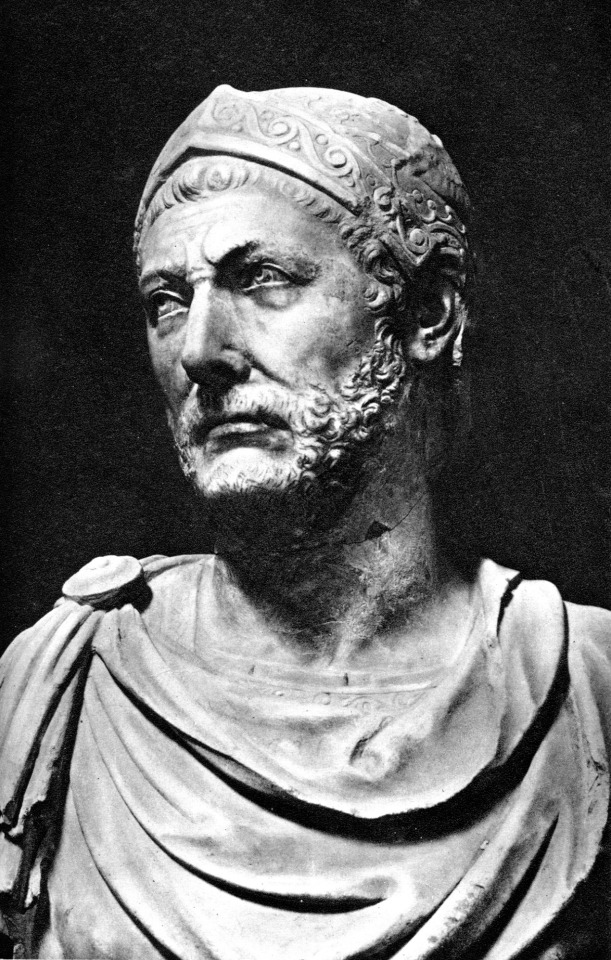


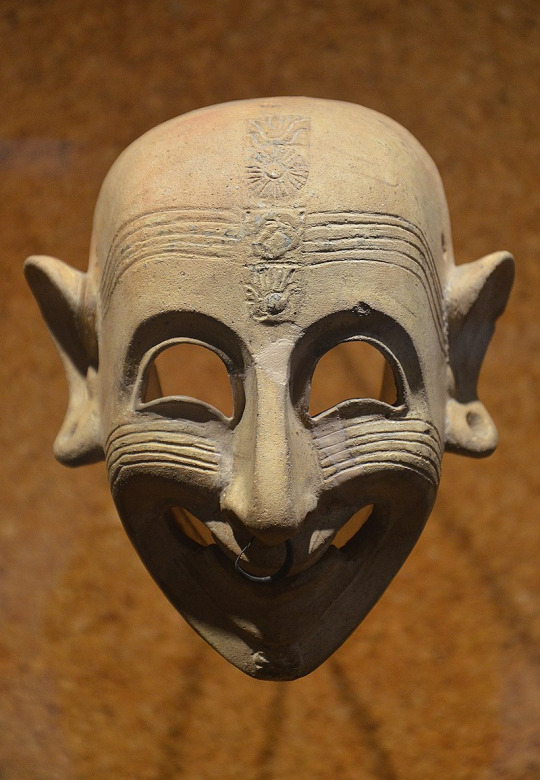



#history#military history#ancient history#ancient world#ancient ruins#ancient carthage#carthage#ancient rome#ancient greece#tunisia#iberia#hannibal#scipio africanus#ancient phoenicia#phoenician#punic wars#sardinia#sicily#corsica#malta#balearic
4 notes
·
View notes
Text
Sack Man
The Sack Man (also called the Bag Man or Man with the Bag/Sack) is a figure similar to the bogeyman, portrayed as a man with a sack on his back who carries naughty children away.
Variants of this figure appear all over the world, particularly in Latin countries, such as Spain, Portugal, Italy (where he is known as the vecchio col sacco ("the old man with the sack"), and the countries of Latin America, where it is referred to as el "Hombre del costal", el hombre del saco, or in Portuguese, o homem do saco (all of which mean "the sack/bag man"), and Eastern Europe. Similar legends are found in Haiti and some countries in Asia.

In Spain, el hombre del saco is usually depicted as a mean and impossibly ugly and skinny old man who eats the misbehaving children he collects. The crime of Gádor gave rise to this term because the kidnapers used a gunny sack to carry with the children. In Brazil, o homem do saco is portrayed as a tall and imposing adult male, usually in the form of a vagrant, who carries a sack on his back, and collects mean disobedient children for nefarious purposes. In Chile, Argentina and particularly in the Southern and Austral Zones, is mostly known as "El Viejo del Saco" ("The old man with the bag") who walks around the neighbourhood every day around supper time. This character is not considered or perceived as a mythical or fantastic creature by children. Instead, he is recognised as an insane murderer that somehow has been accepted by society which allows him to take a child that has been given to him willingly by disappointed parents or any child that is not home by sundown or supper time. In Honduras and Mexico, misbehaving children fear "El Roba Chicos", or child-snatcher, which is very similar to "Hombre del Saco".
In Armenia and Georgia, children are threatened by the "Bag Man" who carries a bag and kidnaps those who do not behave. In Hungary, the local bogeyman, the mumus, is known as zsákos ember, literally "the person with a sack". In Poland children are frightened by the bebok, babok, or bobok or who is also portrayed as a man with a sack. In the Czech Republic and Slovakia, a similar creature is known: bubák. It's a creature without a typical form, connected with darkness or scary places, making children fear but not taking them away usually. The character of čert, the devil, is used for that instead ("Don't be naughty or čert will take you away!"). In Russia, Ukraine and Belarus, buka ("бука"), Babay ("бабай") or Babayka ("бабайка") is used to keep children in bed or stop them from misbehaving. 'Babay' means "old man" in Tatar. Children are told that "Babay" is an old man with a bag or a monster, usually hiding under the bed, and that he will take them away if they misbehave (though he is sometimes depicted as having no set appearance).
In North India, children are sometimes threatened with the Bori Baba or "Father Sack" who carries a sack in which he places children he captures. A similar being, "Abu i Kees" (ابو كيس), literally "The Man with a Bag", appears in Lebanon.] In Turkey, Kharqyt (Turkish: Harkıt means "Sack Man"- also called Öcü, Böcü or Torbalı) is portrayed as a man with a sack on his back who carries naughty children away to eat or sell them.
In Korea, mangtae yeonggam (망태 영감) an old man (yeonggam) who carries a mesh sack (mangtae) to put his kidnapped children in, thus, "Old Man with a Sack". In some regions, mangtae yeonggam is replaced by mangtae halmeom (망태 할멈), an old woman with a mesh sack. In Vietnam, misbehaving children are told that ông ba bị (in the North; literally mister-three-bags) or ông kẹ (in the South) will come in the night and take them away.
In Sri Lanka, among the Sinhalese people, elders frighten misbehaving children with Goni Billa, (translates roughly as "sack kidnapper") a scary man carrying a sack who arrives day or night to capture and keep children.
In the Western Cape folklore of South Africa, Antjie Somers is a Bogeyman who catches naughty children in a bag slung over his shoulder. Although the name is that of a female, Antjie Somers is traditionally a male figure.
Several countries contrast their version of the sack man with the benign sack carrier Father Christmas. In the Netherlands and Flanders, Zwarte Piet (Dutch for "Black Pete") is a servant of Sinterklaas, who delivers bags of presents on December 5 and takes naughty kids back to Spain in the now empty bags.
In some stories, the Zwarte Piets themselves were kidnapped as kids, and the kidnapped kids make up the next generation of Zwarte Piets. In Switzerland, the corresponding figure is known as Schmutzli (derived from Butzli) in German, or Père Fouettard in French.
A similar figure, Krampus, appears in the folklore of Alpine countries, sometimes depicted with a sack or washtub to carry children away. In Bulgaria, children are sometimes told that a dark scary monster-like person called Torbalan (Bulgarian: Торбалан, which comes from "торба", meaning a sack, so his name means "Man with a sack") will come and kidnap them with his large sack if they misbehave. He can be seen as the antipode of the Christmas figure Santa Claus (Bulgarian: Дядо Коледа; corresponding to Father Christmas).
In Haiti, the Tonton Macoute (Haitian Creole: Uncle Gunnysack) is a giant, and a counterpart of Father Christmas, renowned for abducting bad children by putting them in his knapsack. During the dictatorship of Papa Doc Duvalier, certain Haitian secret policemen were given the name Tontons Macoutes because they were said also to make people disappear.
5 notes
·
View notes
Text
Book Review: The Troubled Empire
The Troubled Empire: China in the Ming and Yuan Dynasties, by Timothy Brook. I’m giving this history five out of five, this is exactly the ground-level info I wanted on climate, culture, and the rest of the time period for my points of historical divergence in Colors of Another Sky. And I plan to look up other books and articles by this author. Especially Vermeer’s Hat and everything he wrote on Xu Guangqi. For one thing, this author not only has an extensive bibliography, he sorts it into primary and secondary sources, so you can go straight to the source or read a myriad of interpretations....
Ahem. This is a book Jason would have read, given it covers large chunks of the Little Ice Age in Asia. That gives me not just world-background, but character background. If I take this book as “what he knows”, I then have a good basis for what he’ll see looking around in this world’s present and notice that things are Not Quite Right.
As you can imagine, I have sticky-notes all over my copy. Not just for Jason. Chae would have lived through about a third of these events!
...But mostly because there is so much neat stuff.
A few examples. The author pays particular attention to Chinese records of dragons. Because they were written down as real history, and accounts tend to coincide with upset, upheaval, and all kinds of nasty weather hitting the Empire in both Yuan and Ming.
And we often hear of Chinese referring to places to get rich overseas as “Gold Mountain”. But apparently gold was actually the civilized way to refer to silver. Which was money. Money coming from Spain and Portugal by way of galleons from South America... yet at the time, at least until about 1630, there was just as much silver coming to China from Japan. Especially since Japan had gotten hold of the mercury amalgam process from foreign traders.
(Chae is probably several kinds of ticked about that. She’s a cultivator, from a tradition that now actually works; she knows how nasty cinnabar really is.)
Not to mention that in times when things were going well, and there were times even in the Little Ice Age that it was... there were markets for antiquities that, somehow, always had a few more antiques laying around to show wealthy collectors. To the point that some collectors found spotting the fakes to be part of their fun!
One of the facts I want to chew more on (which also agrees with bits of a book on William Adams, who was in Japan in late Ming) is the fact that mathematics, particularly geometry that helped shape maps, astrological calculations, and artillery fire, is one of the things China and Japan both found most impressive about European areas of knowledge. Hmm.
All told this book is fascinating. I’m definitely going to reread it, and it’s giving me lots of story fodder!
7 notes
·
View notes
Text
Meet Ms. Andorra, my hetalia oc.





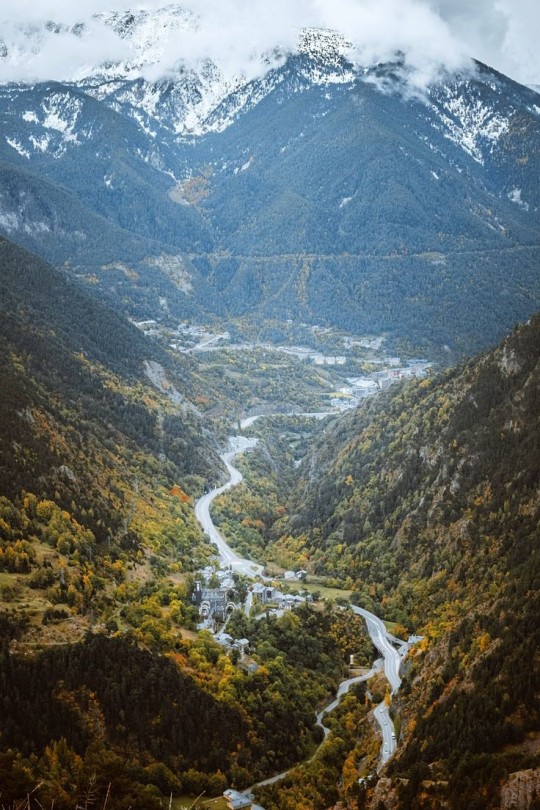



Meritxell Júlia Roca Serra
My Andorra’s name is Meritxell Júlia Roca Serra, almost no one calls her Meritxell and everybody calls her Júlia.
Listen, almost all of the recognized micronations we’ve seen are shown to be rich, but responsible with money, we need one who’s not. (Micronations: Andorra, Monaco, Liechtenstein, Luxembourg and Malta)
She appears energetic and loud, but is mostly trying to compensate for her lonely childhood.
But before she was more quiet, and shy. You could not get a word out of this girl before World War Two, and her personality was more like Liechtenstein’s. Even to this day, when not around other people, or around she trust’s, she’s a lot more quiet.
She’s close with everybody, but nobody at the same time. And she was super lonely growing up, so she tries to compensate.
She’s generally a lot more done with life than the rest of micronations, being neighbors with Spain and France will do that to you.
Definitely a party girl, and the one who’s going to give you bad advice.
Huge smoker, if she wasn’t a nation her lungs would be charcoal.
Despite this, she’s very religious.
Andorra was founded as part of the Spanish March, a military buffer zone between Muslim Spain and The Kingdom of Franks. The military zone was primarily meant to keep Muslims out of France.
Because of this she’s a very experienced fighter, even to this day she has a rifle in her house.
She originally had lots of other siblings, but they all eventually got annexed by Spain or France, so it doesn’t really matter.
She's committed a long list of crimes, most of them include smuggling.
She’s close with both France, Spain and Portugal, but she’s very introverted and shy, not talking to any other nation except the two of them until after World War II
Rich, rich asf, and spends however she likes. Being responsible with money, I never heard of it.
But before she was relatively poor and was more of an agriculture girl.
The recognized microstate gang's her go to and they all hang out whenever they can.
Switzerland doesn’t like her, he thinks she’s a bad influence on Lichtenstein, Austria doesn’t like her for the same reason.
Has a catalan sheepdog named Pol.
South Italy also doesn’t like her, but it’s more of a personality clash.
Big fan of radio, and that’s how she broke out of her shell.
Also is great at skiing, and ice skating.
As a kid she was an avid reader, she loves her country but Andorra is tiny and she never really get to experience the world until now. Reading was the only way to deal with that
Retail therapy is her therapy
Very adventurous today.
Experienced hiker.
Family is France and Spain, and these days her relationship with them is improving.
My first oc post I'm really proud of. This is the start of a very long hetalia blog
5 notes
·
View notes
Text
Gran Turismo 7 accessibility review
Game title: Gran Turismo 7
Platform(s): Playstation 5, Playstation 4
Languages: Matches your Playstation console's default language setting. Czech, Danish, German, English (United Kingdom), English (United States), Spanish (Latin America), Spanish (Spain), French (Canada), French (France), Indonesian, Italian, Hungarian, Dutch, Norwegian, Polish, Portuguese (Brazil), Portuguese (Portugal), Russian, Romanian, Finnish, Swedish, Vietnamese, Turkish, Ukrainian, Arabic, Greek, Japanese, Korean, Thai, and simplified & traditional Chinese are available.
Age rating: ESRB E 10+, PEGI 3
Multiplayer: 2-player local split-screen multiplayer. Online multiplayer up to 20 players in a game lobby. Online profile photo, nickname, cover photo, about me, default greeting, post race greeting, and social links can all be set.
Genre/theme: Racing simulation, circuit races, rally races, championships, license trials, car collection, car customization, screenshot and photo editing.
Violence: None, aside from causing some occasional minor damage to other racers' cars.
Maturity: No sexuality, nudity, swearing, or drugs & alcohol references. A driving experience gamers of all ages will enjoy.
Difficulty modes: Setting a new standard for accessibility, several assists are on by default when starting a new game, and they remain on until you turn them off, making the game very approachable. After trying out various amounts and levels of assists, I found that most of the starting assists really did help my hands a lot. I eventually turned off the visual displays for the drive line and brake zones, but I kept corner markers displayed on-screen (I don’t have very good depth perception), auto-braking around turns (to save my left hand/arm the stress of constant braking), a little bit of ABS, and some traction control (to decrease the amount of counter-steering needed, especially on dirt tracks and rainy levels).
Even when the braking is set to automatic you can still mess up by going into a turn too fast and skidding off course or crashing, so letting off of the accelerator and doing some light manual braking will still be helpful, you won't literally fly off of the track going around a turn crazy fast like you would with the braking assist turned off. You can get a serious boost in speed if you turn off auto-braking and get good at braking manually in GT7, but I've found it to be much harder on the hands. Several of the assists can be turned way up or way down, or off entirely, giving you the freedom to choose every aspect of the game you'd like to fine-tune to your needs and preferences.
The difficulty mode is set to Normal by default but can be set to either Easy or Hard as well, race prize money is not affected by changing difficulty.
There are unlockable bonus races that aren't required for the main story completion that can range up to 5-chili pepper difficulty level; these almost always have increased tire wear and fuel usage, requiring pit stops during the race.
Complexity: As complex or as simple as you'd like it to be; Gran Turismo 7 can play very casually with several assists on, or it can be a hardcore realistic racing sim, and everything in between. Cars can be incredibly fine-tuned and customized or can be driven stock, but some upgrades will likely be needed for later races and championships, and upgrades generally make the game easier to control.
Instructions, saving, story recap, menus, & waypoints: There is a link to the online manual on the main menu screen. Controls and skills are learned and practiced by playing through the license trials. Menus are mostly pretty easy to navigate and find what you're looking for, but the text size is kinda small. In-game notifications are clear and reliable, creating a marker on which gaming mode area to select for your current goal.
There isn't much of a story beyond collecting cars and winning all the championships, as is true of the Gran Turismo series as a whole.The Cafe is your source of obtaining new goals and rewards, and also offers some brief history about the cars and manufacturers.
In-game notifications can be turned off. Autosaves often, after every race; I had the game crash a time or two and never lost any progress (in earlier builds, they release update patches often). Can turn opening movie and demo off to speed up load time.
Subtitles: Relies entirely on subtitles, the text is fairly small and appears at a medium pace.
Text customization: "Skip conversations using cancel" is the only dialogue option available. Unit of measurement can be switched between mph and kph.
Voice acting: None
Volume settings: Balanced BGM (background music) and sound effects mode, enhanced sound effects mode, race BGM focus mode, menu sound effects level, play race BGM, race BGM level, race sound effects level, replay BGM level, replay sound effects level, music replay volume balance, music replay master volume level, other BGM level, engine sound level, transmission sound level, tire squeals level, rivals engine sound level, broadcast mode, and audio output mode: 2 channel stereo or 7.1 channel surround are all customizeable. In-game notifications for the current song playing pop up in the upper right corner, and songs can be removed from the default playlist.
Photosensitivity: Exposure, color saturation, bright level, and dark level can all be adjusted.
There aren't many flashing lights in the race track environments (primarily on a couple of the road courses in Japan), the main flashing light issue is on the heads-up-display, as it flashes blue, white, and red while shifting gears (the entire heads-up-display can actually be turned off in the in-race settings menu though). Additionally, whichever setting you hover the cursor over in the Settings menu flashes between dark gray and white. Some cars emit a bit of an exhaust flash when shifting up a gear, this is more noticeable on night levels.
These can be remedied a bit by playing in a well-lit room and adjusting screen brightness (TV), backlight (TV), contrast (TV), and color settings (TV). Additionally, wearing blue light lens glasses, tinted lens glasses, or even sunglasses may be helpful.
Motion sickness: Driving in first-person perspective is really accurate with car interiors and is well done but may be too much too for gamers who struggle with fast images/high speeds, I personally found this to be a bit better in third-person camera mode. The camera can be changed with the press of a button, so you could even switch between camera modes several times in a race if different perspectives on certain turns or lighting areas are easier for you. There are four camera angles to choose from: third person (behind the vehicle and up about 25–30 degrees), first person, dash-cam, and front of the car. The sideposts and lamp posts blend together in a slightly disorienting way on particularly fast tracks/driving fast cars, but this can be remedied by placing your eyes’ focal point directly in front of the car.
Colorblindness settings: Color saturation can be customized, but no colorblind mode.
Controller rumble: Yes, vibration level can be customized or turned off entirely.
Remappable controls: 100%, every button can be remapped.
Quick-time events: None, aside from timed starts and early start penalties on some of the tougher races.
Physical impact: Low with assists on, moderate with all assists turned off. I haven't tried this game with a racing wheel or wheel + pedals setup. There are lengthy optional endurance races you can take on, which I found to be too fatiguing and painful, but completing these isn't necessary.
I played through the game on Playstation 4, but a friend of mine who played through it on Playstation 5 messaged me after reading this review to let me know that the Playstation 5 Dualsense controller caused him some additional pain and fatigue due to the controller's adjustable trigger tension level. Thankfully, the trigger tension can be turned down or off entirely to relieve this.
Adaptability and input: To play one-handed, a racing wheel + pedals setup will likely be needed. Can be played with Sony Playstation 5 Dualsense controller, Sony Playstation 4 Dualshock 4 controller, Fanatec GT DD Pro racing wheel, Fanatec CSL Elite racing wheel, Fanatec Podium racing wheel, Logitech G G29/G923 racing wheel, Logitech G PRO racing wheel, Thrustmaster T-GT racing wheel, Thrustmaster T-300RS racing wheel, Thrustmaster T-500RS racing wheel, Thrustmaster T150 Force Feedback racing wheel, and Thrustmaster T80 racing wheel.
Upgrades that can be purchased for each car include increasing the steering angle, installing a handbrake for easier drifting around turns, as well as nitrous boost.
Overall accessibility score: 4.5/5.0
(Please note that this score does not reflect the entertainment or enjoyment value of the game, it represents the range of accessibility for gamers who have specific limitations.)
With Gran Turismo 7, Sony and Polyphony have set a new standard for excellence in accessibility in racing games. A wide range of languages, complete control remappability, compatibility with several racing wheel setups, in-depth lighting, camera, and sound settings, along with all of the gameplay and visual assists you could ever want, all add up to an incredibly approachable driving experience. Some mild photosensitivity and motion-sickness, but these can be remedied by various means, and aren't anywhere near as intense as you'd expect from a driving game. The greatest accessibility omissions are the lack of voice acting and text customization settings. Who knows, with all of the updates being released for this game (and maybe a little encouragement from us) there's a chance text customization settings could be added one day!
My review can also be read and listened to (text-to-speech) at Medium.com:
https://medium.com/@AbleGaming/gran-turismo-7-accessibility-review-8597bb979988
#video games#gaming#acessibility#accessibility in gaming#disability#disabilities#parenting#game reviews#gran turismo#gt7#playstation
6 notes
·
View notes
Note
Got a list of books on Port for any of us anon's who enjoy physical books to order online or from a bookstore?
Oh, man, I do most of my research online these days :(
But I'll point you to some tips that might help you!
What you can do is go to a bookstore and see what they have. They'll probably have a broad, mostly washed up, version of Portuguese history, but that will serve as your base and you can build on top of that.
It's important to get multiple sides and what's wonderful about studying Portuguese history is that you'll find a little something about them pretty much everywhere in the world. If you read it from a Portuguese author, specially if it's an older pre-Revolution book, you'll often find it to be a little too patriotic, and if you read it from a British author, you'll often find it to be a little too patronizing. So take both with a grain of salt.
I recommend you touch the following periods: Roman colonization, Islamic conquest, Independence and reconquista, Age of Discovery, Iberian Union, the Portuguese Inquisition (especially in India), Independence from Spain, the discovery of gold in Brazil, the 1703 Treaty of Cloth and Wine with England, the 1755 Lisbon Earthquake, the Seven Years War, the Napoleonic Wars (both the escape of the royal family to Brazil and the resistance in Portugal), Beresford in Portugal, Brazilian Independence, the Liberal Wars, the reign of D. Maria II, the Berlin Conference and the partition of Africa, the Pink Map and the British Ultimatum, the assassination of D. Carlos I, the fall of the Portuguese monarchy, Portugal's participation in WWI, Salazar, Portugal's participation in WWII, the Colonial Wars, the Carnation Revolution and the independence of Timor Leste.
(it's a big list I know, but you don't have to get a book that has all of that, you can get one that gives you a broader picture and then search for more information individually)
Other topics I found to be really interesting during research:
Portugal's trade in the Golf of Guinea and trade with the Kingdom of Benin;
Portugal's relation with the Kingdom of Kongo;
The volta do mar;
Luso-Japanese relations, in special the fallout;
Sino-Portuguese relations, in special the awkward beginning and the lease of Macau;
British presence in Macau and Portuguese presence in Hong Kong;
Swedish-Portuguese salt trade in the 17th century (Portugal's salt trade in general is a very interesting read);
The Ottoman-Portuguese War in the Indies;
Portugal conquest of Malacca and the Indies.
And if you have the will and the time, I strongly recommend you read the literature. Gil Vicente, Eça de Queiroz, Saramago, you're in for a treat!
#and if you ever want digital links to research articles hit me up!#you'll also find a lot of them in the notes for 'In this universal river'#It's a lot fo work but it's also very cool#and to me as a Brazilian very enlightening too#asks
4 notes
·
View notes
Text
Week 7: Sustainability in Madrid - Pt. 2
Hello and welcome back! As promised, I have compiled a list some of my favorite ways to travel and live sustainably. These are some of the things that I did when I was in Madrid and traveling around to reduce my impact.
Bringing my water bottle with me – This might seem most obvious, as most people at Michigan already bring their own bottles to class, but it’s important – most of the waste of a plastic bottle occurs upstream before you even buy it! Madrid has some of the BEST tap water in the world, and you can find drinking fountains everywhere around the city that consistently have good water. Even the bathroom tap water is good!
Reusing jars – I unfortunately did forget my reusable “ziploc” bags for snacks and things, so I started collecting jars. Yogurt containers are great for storing any leftovers, and any glass jar makes for a great coffee mug!
Using your own coffee cup – I was unsure if they would allow it, but my favorite coffee shop let me use my own jar for coffee. This is a great way to stay circular and limit your waste impact! Most of the time coffee is a social outing, so you use the glassware there. But for those caffeine pick me ups between class I would always have a jar on me. Fun fact, most paper coffee cups aren’t even recyclable because they have a plastic liner on the inside :(
Walk – The beauty of living in a big city, especially Madrid, is that everything is walkable. Madrid is considered a 15 minute city, meaning everything you could need is only a 15 minute walk or bike ride away. I even opted to walk to class because it was more efficient than taking the metro.
Compost – Don’t forget to compost your food scraps! Madrid has a really good waste system, so it’s really easy to compost and recycle everything.
Fruit stands – I love that it is super easy to find fresh produce (and mostly locally grown) produce on every corner. Instead of buying fruit at a Día or Carrefour (the most commonly found supermarkets), opt to support the local economy and get any produce from your favorite fruit stand. Just make sure to politely let them know that you want to skip the plastic bag!
Tote Bags – this is an essential item, and it’s easy to pack! This is multifunctional and is great for groceries, school, a picnic, or just a day bag in general. Heads up, they charge you for plastic bags in Spain, so this is a great alternative.
Picnic lunch – I happened to have a little break between my classes, so I would bring my lunch (in one of my reused containers of course) and find a nearby park to decompress and refuel.
Clothes – Fast fashion is everywhere in Spain, and I beg of you to resist the temptation, (trust me) don’t buy from companies like Zara or Bershka if you can avoid it! If you forgot something, or are in the shopping mood, check out the vintage stores in Malasana, or find a Humana (there are so many of these) instead.
Traveling – If you plan on traveling for a weekend, opt to take a train if possible. Prices will be cheaper if not the same as a flight, and oftentimes trains are a much more efficient even if the journey is a little longer. Plus, you don’t have to worry about luggage fees etc. Madrid has two stations, and I recommend using Omio or Trainline for booking trips. If I haven’t convinced you already, traveling by train also reduces your carbon footprint substantially!
Packing up and Leaving – instead of throwing away things like non-perishable foods, clothing, or household goods, find a local charity or ask the school if you can donate things for future students!


Picture 1 - Staying hydrated and enjoying the view of the Clerigos tower in Porto, Portugal. Picture 2 - I loved bringing my tote bag with me everywhere. I could carry my water, a fan, and my wallet. An added bonus: it's easy to keep close to you, so the risk of being pickpocketed is significantly lower. Lucky to say I haven't had any issues with this!
These are just a few tips on how to reduce your impact abroad, or even things you can do back in Ann Arbor! Remember that sustainability is going to look different for everyone. We don’t need everyone doing zero waste perfectly, but a lot of people working to make small changes to their current habits. I hope you learned something new and try these recommendations out! Good luck, you’ve got this :)
0 notes